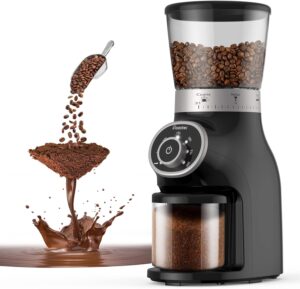Dry coffee grinders are versatile kitchen tools that can grind various foods beyond just coffee beans. Their powerful blades and compact design make them suitable for grinding a variety of dry ingredients into fine powders or coarse textures. Here are some foods you can grind with a dry coffee grinder, along with the process and the expected outcome:

1. Spices and Herbs:
Process: Add whole spices or dried herbs to the coffee grinder’s grinding chamber. Pulse the grinder at short intervals to achieve your desired texture, from coarse to fine powder. Shake the grinder occasionally to ensure even grinding.
Outcome: Freshly ground spices and herbs release their aromatic oils, enhancing the flavour of your dishes. Ground spices like cumin, coriander, fennel, and chilli peppers can be used in marinades, rubs, and spice mixes. Ground herbs like oregano, thyme, and rosemary add depth to sauces, dressings, and seasoning blends.
2. Nuts and seeds:
Process: Add nuts or seeds to the grinding chamber, being careful not to overfill it. Pulse the grinder in short bursts, shaking it occasionally to ensure even grinding. Stop grinding when you reach your desired texture, from coarse meal to fine powder.
Outcome: Freshly ground nuts and seeds have a richer flavour and retain more nutrients than their pre-ground counterparts. Ground almonds, hazelnuts, or pistachios can be used for baking, coating proteins, or making nut butter. Ground flaxseeds, chia seeds, or hemp seeds can be added to smoothies, yoghurt, or baked goods for a nutritional boost.
3. Grains and Pseudocereals:
Process: Add grains or pseudocereals like quinoa, amaranth, or buckwheat to the grinding chamber. Pulse the grinder in short bursts, shaking it occasionally to ensure even grinding. Grind until you achieve a fine powder or coarse meal consistency.
Outcome: Freshly ground grains and pseudocereals can be used to make gluten-free flours for baking or as a nutrient-rich addition to smoothies, porridges, or baked goods. Ground oats can be used for making oat flour or added to meatballs or veggie burgers as a binder.
4. Rice and Legumes:
Process: For rice, add the grains to the grinding chamber and pulse until you achieve a fine powder or coarse meal consistency. For legumes like lentils or chickpeas, it’s best to grind them in smaller batches to avoid overheating and ensure even grinding.
Outcome: Ground rice can be used to make rice flour for gluten-free baking or as a thickener for sauces and soups. Ground legumes like lentils or chickpeas can be used to make flour for flatbreads, and fritters, or as a gluten-free baking substitute.
5. Sugar and Salt:
Process: Add sugar or salt to the grinding chamber, being careful not to overfill it. Pulse the grinder in short bursts, shaking it occasionally to ensure even grinding.
Outcome: Freshly ground sugar or salt can add texture and visual appeal to baked goods or savoury dishes. Ground sugar can be used to make flavoured sugars by grinding them with spices or citrus zest. Ground salt can be used as a finishing salt or to create flavorful salt blends with herbs or spices.
6. Coffee beans:
Process: Add whole coffee beans to the grinding chamber. Pulse the grinder in short bursts, shaking it occasionally to ensure even grinding. Adjust the grinding time and the number of pulses to achieve your desired grind size, from coarse for the French press to fine for espresso.
Outcome: Freshly ground coffee beans have a richer aroma and flavour compared to pre-ground coffee. The grind size can be customized to suit your brewing method, enhancing the overall coffee experience.
7. Breadcrumbs:
Process: Break stale bread or crackers into smaller pieces and add them to the grinding chamber. Pulse the grinder in short bursts until you achieve the desired breadcrumb texture, from coarse to fine.
Outcome: Fresh, homemade breadcrumbs with a superior flavour and texture compared to store-bought varieties. Use them for coating proteins, topping casseroles, or as a binding agent in meatballs or veggie patties.
8. Crackers and Chips:
Process: Break up crackers or chips into smaller pieces and add them to the grinding chamber. Pulse the grinder until you achieve a fine crumb consistency.
Outcome: Freshly ground crackers or chip crumbs can be used as a crunchy coating or topping for baked dishes, and casseroles, or as a binding agent in recipes like crab cakes or veggie burgers.
9. Chocolate:
Process: Break up blocks of chocolate into smaller pieces and add them to the grinding chamber. Pulse the grinder until the chocolate is ground into a fine powder.
Outcome: Freshly ground chocolate powder can be used for baking, making hot chocolate mixes, or as a topping for desserts and beverages.
When using a dry coffee grinder for grinding various foods, it’s essential to follow a few guidelines:
1. Clean the grinder thoroughly before and after each use to avoid cross-contamination of flavours.
2. Grind in small batches to ensure even grinding and prevent overheating, which can affect the flavour and texture of the ground ingredients.
3. Adjust the grinding time and number of pulses based on the desired texture and the hardness of the ingredients.
4. Store the ground ingredients in airtight containers to preserve their freshness and flavour.
Remember, a dry coffee grinder is best suited for grinding dry, hard ingredients. For wet or sticky foods, a dedicated blender or food processor may be more appropriate. With a little experimentation and attention to detail, a dry coffee grinder can become a versatile tool in your kitchen, allowing you to grind a variety of ingredients for added flavour, texture, and nutritional value in your culinary creations.
Check-out things you could do with the Nutribullet Blender
FOLLOW on Instagram
SHOP WITH US TODAY

